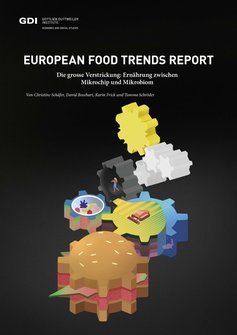Der nachfolgende Text basiert auf einem Auszug aus dem «European Food Trends Report 2021», der über unsere Website bezogen werden kann.
Ähnlich wie Pflanzenschutzmittel die Landwirtschaft im Kampf vor Schädlingen, Unkraut und Missernten deutlich nach vorn gebracht haben, so hat auch die Medizin im Kampf gegen Krankheitserreger erhebliche Erfolge zu verzeichnen: Noch um 1900 starben die meisten Menschen an Tuberkulose, Lungenentzündungen und anderen Infektionen. Doch mit der Hilfe von Antibiotika und einer besseren Hygiene konnte vielen Infektionskrankheiten der Schrecken genommen werden.
Damit enden die Parallelen allerdings nicht: Denn ebenso wie in der Landwirtschaft, so stellt sich auch in der Medizin längst die Frage: Haben wir es vielleicht übertrieben? Haben wir am Ende nicht nur die Schädlinge und Krankheitserreger bekämpft, sondern auch vielen nützlichen Organismen den Garaus gemacht? Haben wir ganze Ökosysteme aus dem Gleichgewicht gebracht? Für die Umwelt um uns herum sind diese Fragen nicht neu. Im Hinblick auf den Menschen aber sind sie ungewohnt: der Mensch als kränkelndes Ökosystem, als «Wirtstier».
Feststeht, dass das Mikrobiom von Bewohnern industrialisierter Länder und dort vor allem von Städtern deutlich weniger Mikrobenarten beherbergt als jenes von Menschen, die naturnäher oder zumindest doch auf dem Land leben. Und es mehren sich die Hinweise, dass diese Artenarmut vor allem in unserem Darm eine der Ursachen dafür sein könnte, dass Autoimmunerkrankungen wie Allergien und entzündliche Krankheiten in den vergangenen Jahrzehnten in den Industrieländern deutlich zugenommen haben. Sie könnten letztlich Ausdruck eines gestörten Ökosystems sein, eines Ökosystems, das nicht genügend mit anderen Ökosystemen verwoben, nicht genügend «entangled» ist.
Zumindest hat sich dieses Ökosystem in der Vergangenheit so stark verändert, dass einige Forscher bereits von einem «industriellen Mikrobiom» sprechen. Gekennzeichnet ist es dadurch, dass viele nützliche Mikroben im Darm kaum oder gar nicht mehr vorkommen. Ein Grund dafür: Es fehlt ihnen an Ballaststoffen, die zwar vom Menschen nicht verdaut werden können, die aber ausgezeichnetes Futter für viele Bakterien sind. Kommen diese sogenannten Präbiotika in der Ernährung zu kurz, weil zu wenig pflanzliche Lebensmittel auf dem Speiseplan stehen, nimmt die Vielfalt des Mikrobioms ab und auch der Gesundheitszustand wird meist schlechter. Während die Ballaststoffe in der modernen Ernährung meist zu kurz kommen, sind einfache Kohlenhydrate und Fette meist zu stark vertreten. Sie verschlechtern die Zusammensetzung des Mikrobioms ebenso, wie eine häufige Verwendung von Zusatzstoffen wie Emulgatoren und Süsssungsmittel. Beides, so zeigen Studien, kann Darmentzündungen und Adipositas fördern. Wer viele Süssstoffe zu sich nimmt, hat darüber hinaus oft eine veränderte Zusammensetzung der Mikrobiota, die jener von Typ-2-Diabetikern gleicht.
Was also tun, wenn all diese wichtigen Dienstleistungen nicht mehr richtig funktionieren? In der Natur versuchen wir oft – mehr oder minder erfolgreich – verdrängte Arten wieder anzusiedeln und Ökosysteme wieder aufzuforsten. Genau das probiert man beim Menschen nun auch.
Eine dieser Renaturierungsmassnahmen ist die bereits zuvor geschilderte Stuhltransplantation. Dabei wird eine Stuhlprobe gesunder Probanden aufgearbeitet und dann in den Darm kranker Menschen verpflanzt.
Statt eine komplette, fremde Artenzusammensetzung in ein gestörtes Ökosystem zu transferieren, kann es deshalb hilfreicher sein, das Ökosystem Stück für Stück aufzuforsten: Durch mehr Kontakt zu Mikroben aus unserer Umwelt, durch viel Bewegung, weniger Stress und vor allem: indem wir den wichtigen Mikroben in unserem Darm genügend Nahrung verschaffen (s. Abbildung).
infografik_dos_donts_gesundes_mikrobiom.pdf
Dabei scheint allerdings nicht nur entscheidend zu sein, welche Produkte wir zu uns nehmen, sondern auch, wie sie hergestellt wurden. Denn auch Pflanzen besitzen ein Mikrobiom, das ihre Gesundheit, den Nährstoffgehalt und den Ertrag massgeblich mitbestimmt. So wie Antibiotika das menschliche Darmmikrobiom und seine Funktion stark verändern können, hat der Einsatz von Herbiziden, Fungiziden und Pestiziden in der Lebensmittelproduktion drastische Auswirkungen auf das pflanzliche Mikrobiom im Boden und auf das Obst und Gemüse, das wir essen. Der steigende Einsatz von Düngemitteln und Herbiziden sowie die Bodenerosion und der Klimawandel wirken sich auch auf die mikrobielle Biodiversität aus und tragen zum Verlust grosser Ackerflächen und ihrer mikrobiellen Populationen bei. Dadurch fehlen den Kulturpflanzen heute viele ihrer wichtigen symbiotischen Partner, die den Gehalt an Vitaminen, Mineralien, Antioxidantien und anderen Stoffwechselprodukten produzieren oder erhöhen, die für die Gesundheit von Pflanzen und Menschen von Nutzen sind. Dies ist nur eines von vielen Beispielen dafür, dass der Mensch und seine Umgebung «entangled organisms» – verstrickte Organismen – sind. «Der Mensch ist ein völlig in die Landschaft integriertes Ökosystem», fasst der Neurowissenschaftler und Philosoph Tobias Rees vom kalifornischen Berggruen Institute diese komplexen Verflechtungen zusammen.

GDI-Studie Nr. 50 / 2021
Sprache: Deutsch, Englisch
Format: PDF, 50 Seiten